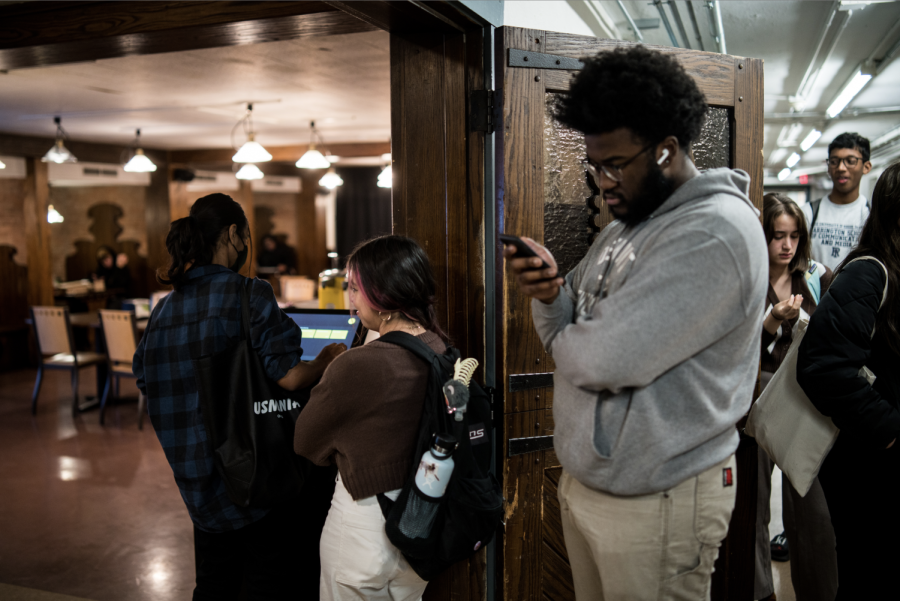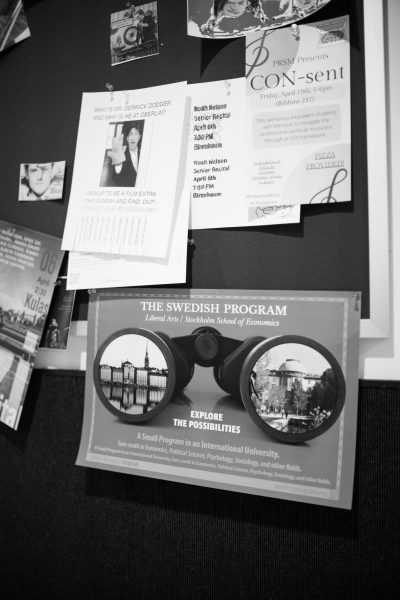Automated Ordering Systems Don’t Improve Workers’ Conditions
Students wait in line to use the kiosk at the Rathskeller.
As someone who’s been here for less than two years, I’ve already seen a lot of changes in my time at Oberlin. My friends and I discuss these changes constantly — it seems as though the comparisons to our first year are endless. Lately, the change we’ve been talking about the most has been the new automation systems in the dining venues on campus. The new automation has had some positive effects — a few of my more introverted friends find the new system much less stressful, and I personally prefer the new system in Biggs because shouting over three running blenders at once last year was difficult. However, the persistence of lines at dining locations with automated ordering has been a prominent issue for all of us. The overcrowding of these spaces has lead me and my friends to avoid getting food at times we know there’s going to be a rush, shifting our eating schedule to unusual hours.
However, most of our discussion of these new changes is less focused on the impacts they have on us as students and more about why the College chose to switch to automation and what it means for workers whose jobs have been altered or replaced. One could argue, from the College’s perspective, that this change has been positive. You could frame it as an attempt to reduce long lines, improve efficiency, and reduce workloads of AVI Foodsystems staff. While this may be a part of the story, Oberlin, like any college, has to think about cost, and I don’t think automation would have been introduced if it wasn’t expected to save the school money.
The rhetoric of this automation being good for workers interests me because I’ve observed long lines at all of the newly automated facilities, orders coming in faster than ever, and AVI workers still struggling to keep up. In my opinion, what could actually help both students and staff would be increasing the number of workers at these sites. I believe things would run more efficiently if people were not constantly overworked and dining locations were not understaffed. This would be a way for Oberlin to focus on genuinely improving labor conditions.
I want to clarify that I’m not saying all automation is terrible; it often does make ordering more efficient. The most significant issues with automation exist when the profit motive comes before one’s consideration for workers. Automation frequently leads to fewer jobs and more tenuous worker positions. A lot of students like the new automation and it could be helpful in the long run. It’s not the automation itself that I have a problem with. I’d only like to point out that this recent automation is a noticeable symptom of how Oberlin treats its workers.
This has been a relevant issue since the beginning of the COVID-19 pandemic, as the College’s outsourcing to AVI received heavy criticism from students for the way the College put money ahead of workers and labor values. The College outsourced the jobs of 108 unionized workers mid-2020, many of whom had been at Oberlin since the early ’90s, and decided to contract with AVI as a new dining provider. This, for me, indicates a history of cost-cutting, which is why I doubt Oberlin would automate without a solid financial incentive. Automation almost always saves money by reducing the number of workers needed, and I expect that it has done this for the College. It would not surprise me if Oberlin were continuing to cut down on workers, mainly because the College has received criticism for laying off dining and custodial workers for the past several years.
In the past, multiple student workers have given us insight into how AVI functions and what it’s like to work in Campus Dining Services. In his piece, “We Must Take Action to Protect AVI Workers,” Gabe Stefanides, OC ’22, wrote about his experience with a policy of termination after six missed days of work and complete ambivalence from higher-ups. The policies Stefanides describes emphasize that AVI is, of course, a corporation and may not put workers’ best interests first. “AVI Student Staff Overworked, Undertrained” by College fourth-year Desmond Hearne-Morrey described a lack of training and long work hours with very few breaks, as well as instances of student employees being encouraged to work more than their regular hours, especially when their shifts suffered from a shortage of staff members, to finish tasks like cleaning dishes.
It’s dubious that the shift to automation will bring better conditions for workers, and it also isn’t doing much for students. I have not noticed much of a decrease in wait times since last year, and I think a big part of that is that these changes weren’t paired with better labor practices. AVI workers are still overwhelmed, and the best ways to change that would likely not save the College money. Thus, it is now more critical than ever that Oberlin students support the AVI labor union and stay mindful of labor issues at Oberlin.



